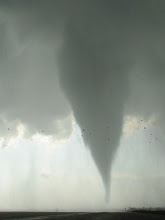This is a relatively brief forecast update. The 00Z NAM last night brought some new concerns to the mix, and 12Z observations and new model guidance this morning continues to show a somewhat tricky severe weather forecast.
The dryline play is looking less impressive. The main axis of the mid-level wave has been forecast to slow down considerably, as evident in this morning's water vapor imagery... and will scarcely help at all with respect to surface-based initiation this afternoon. Instead, an impulse embedded in the base of the trough, crossing far northern Sonora/Chihuahua attm, is more likely to be a player as it ejects toward northwestern TX near peak heating. The 12Z DRT RAOB indicated 100mb ML dewpoints of 63F+ which will easily be drawn northward ahead of the length of the dryline... and with fairly strong heating still expected in at least a narrow corridor, 1000-1500 J/kg MLCAPE remains likely. However, initiation may be fairly localized due to the far more modest nature of the synoptic scale forcing for ascent... and in turn, a weaker dryline circulation. Another concern is that the last couple runs of the NAM-WRF support the GFS trends of fully re-developing the 40-kt LLJ eastward toward the I-35 corridor... considerably reducing low-level shear. Accordingly, the best bet for tornadoes off the dryline may be with storms crossing the surface warm front, which may be near the couple rows of TX counties south of the red river. Hodographs here will be modestly enlarged due to backed surface flow.. however, with mid-level flow of ~60kts, storms may outrun any favorably surface-based environment fairly quickly.
If sufficient cloud breaks occur, moderately strong instability may shape up across the Texas Hill country today well in advance of the dryline as rich moisture influx (ML dewpoints of 64-68F) occurs from deep south Texas. Any storms that manage to form here would have an enhanced tornado threat as they approach I-35 in the Waco to Austin corridor. Short-term models are pretty inconsistent with regard to how much heating and destabilization will occur here, and a mechanism for achieving lift and convective initiation in this area seems nebulous as well... so the forecast there is similarly tricky, at least from what I've looked at thus far this morning.
Monday, November 10, 2008
Subscribe to:
Post Comments (Atom)

No comments:
Post a Comment